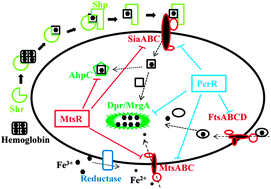Iron acquisition and regulation systems in Streptococcus species
Abstract
Gram-positive Streptococcus species are responsible for millions of cases of meningitis, bacterial pneumonia, endocarditis, erysipelas and necrotizing fasciitis. Iron is essential for the growth and survival of Streptococcus in the host environment. Streptococcus species have developed various mechanisms to uptake iron from an environment with limited available iron. Streptococcus can directly extract iron from host iron-containing proteins such as ferritin, transferrin, lactoferrin and hemoproteins, or indirectly by relying on the employment of specialized secreted hemophores (heme chelators) and small siderophore molecules (high affinity ferric chelators). This review presents the most recent discoveries in the iron acquisition system of Streptococcus species – the transporters as well as the regulators.


 Please wait while we load your content...
Please wait while we load your content...